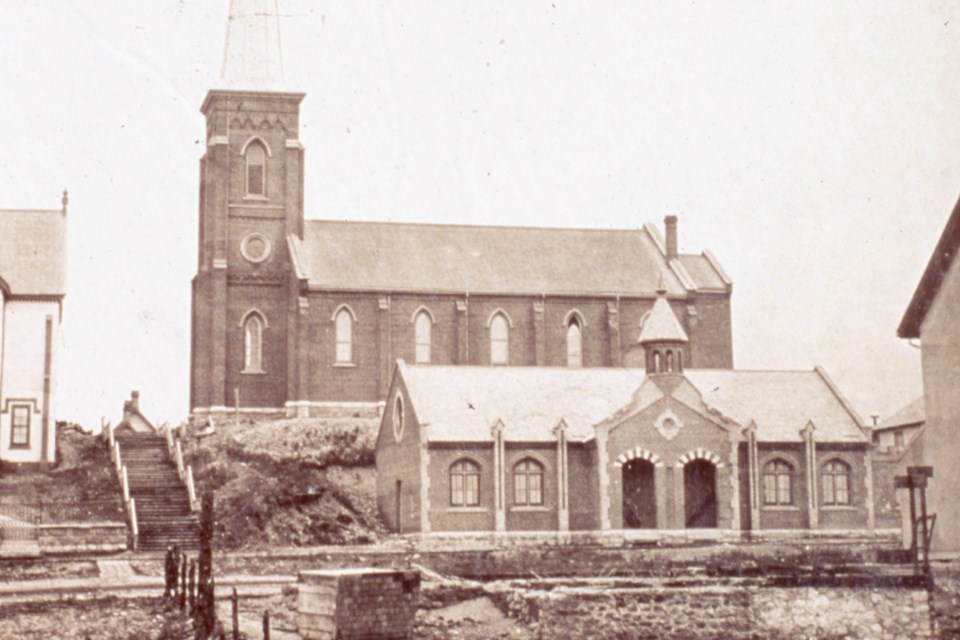This ongoing series from Barrie Historical Archive curator Deb Exel shows old photos from the collection and one from the present day, as well as the story behind them.
Most early churches in pioneer communities started out simply and humbly: groups would gather to worship in private homes or even barns, until an actual church building could be constructed.
Often a sole rector would travel from village to village until a permanent clergyman could be assigned to a parish. It was a common occurrence, regardless of the denomination.
The first Trinity Anglican Church was built in 1835, on Berczy Street, just east of the Barrie Court House. The primitive church and its tiny cemetery overlooked the bay and growing settlement below,
The Anglican Church was allocated a parcel of land in 1836, to be used as a Glebe. This area was located on the south side of Dunlop Street between Memorial Square and Five Points down to Marks (now Simcoe) Street. The block was not used for church business, but was leased out for income.
As the congregation and their families grew, so did the church’s needs. A rectory and schoolhouse were built on the Glebe in 1851.
The school was well used. Through the week, pupils attended classes and on the Sabbath, the building became a Sunday School. In the winter, services were held in the school when it was impossible to get up the steep hill to the church on Berczy Street.
Planning for a new church in a better location consumed the years from 1856 until 1864. Although two lots on Worsley Street were selected, the old church was simply enlarged instead, in 1857. However by 1861, a committee had formed and began fundraising in earnest for a new church building.
By 1864, construction was underway. A two day bazaar was held in the Town Hall, in support of the building fund. The newspaper compelled the community to turn out: ‘The exertions of the ladies in behalf of the fund deserve a liberal patronage and we have no doubt that those of our townspeople who do not visit the Bazaar from a sense of duty will be impelled thither by a feeling of gallantry. Attractive goods, smiling faces and bright eyes, must make this world’s paltry dross seem of as little consequence as are “Yankee Greenbacks” in the eyes of the New York bulls and bears.’
The cost of admission to the bazaar was five cents in the afternoon and 10 cents for access in the evening. The tables and refreshment booth were manned by men and women from Barrie’s most prominent families, recognizable names such as Sanford, Ardagh, Lount, Meeking, Morgan, Ross, Boys and Strathy. The bazaar raised an impressive $1,132.72 for the new church.
Later that fall, another successful fundraiser was held. Pews in the new church were auctioned off, the highest bidder having first choice of seating location. So successful was the auction, that seating was oversold and the opening of the church delayed until a gallery could be built.
On Dec. 23, 1864, exactly 159 years ago, plus a day, the new church officially opened.
In 1870, the wardens of the church sold off the school lots down on Marks (Simcoe) Street and began building a new school. This was fortunate timing as the rectory and school on Marks Street burned in the fire that destroyed the Glebe Block in 1871.
Unlike the church, which was designed by an architect from London, Ont., the plans for the new school were provided by local architect Shearman Bird, and the building constructed on lots donated by Judge Ardagh. The new Gothic-styled school with its charming bell tower and massive roof beams was a striking building. Some materials from the first church, such as memorial windows and pew doors, were reused in the new structure.
The Berczy Street church would later be abandoned.
Once again the school house became a multipurpose building, functioning as both a Sunday School and a parish hall. And like the school before it, the building would be a temporary sanctuary, not due to icy roads but as a result of a fire caused when lightning struck the church in 1934, completely destroying the interior. The steeple was never replaced.
Decades later, a canvass of the parishioners revealed support for a new hall. In May 1957, following a service of remembrance and thanksgiving in the old school, the demolition of the historic building would begin.
In 1958, the new parish hall on Collier Street opened. Architectural items rescued from the 1835 church which had been integrated into the 1870 school, were preserved in the sacristy of the church.



